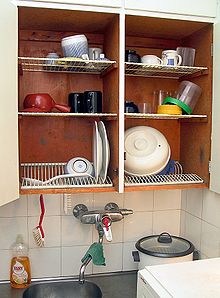- Dish draining closet
-
The dish draining closet is a Finnish invention by Maiju Gebhard, intended to speed up the drying up of washed dishes, or even to make the entire drying phase unnecessary. It was developed in the Finnish Association for Work Efficiency from 1944 to 1945. The Finnish Invention Foundation has named it as one of the most important Finnish inventions of the millennium. Despite its advantages, the dish draining closet is not very popular outside Finland and has mostly remained a Finnish speciality. There are some dish draining closets in use in Ukraine, Sweden, Spain, Iran , Italy,[1] Poland, Russia, South Korea, Lithuania, Latvia, Estonia and Israel.
The inspiration for the dish draining closet was a Swedish dish draining holder, which was kept on a table. Gebhard noticed that most families never used the holder, but instead dried the washed dishes by hand and moved them directly to the storage closet or cupboard. Gebhard's idea was to put the dish draining holder in the closet above the dish washing table (sideboard or counter top), so the dishes could drain dry in place. This way, an entire phase of normal household upkeep could be skipped. According to Gebhard's calculations, the average housewife spent almost 30,000 hours of her life washing and drying dishes.[2]
Enso-Gutzeit started producing dish draining closets in 1948. Since 1954, dish draining closets were made of plastic-coated steel wire to help keep them clean. The measurements for the closets were standardised in 1982.
The cabinets have an open bottom that allows for the water to drain directly into the sink below.
References
Categories:- Home appliances
- Finnish culture
- Finnish inventions
Wikimedia Foundation. 2010.

